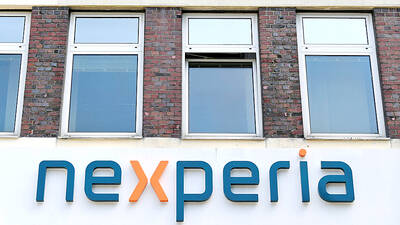Application-specific integrated circuit designer Faraday Technology Corp (智原) yesterday said that although revenue this quarter would decline 30 percent from last quarter, it retained its full-year forecast of revenue growth of 100 percent.
The company attributed the quarterly drop to a slowdown in customers’ production of chips using Faraday’s advanced packaging technology.
The company is still confident about its revenue growth this year, given its strong “design-win” — or the projects it won to help customers design their chips, Faraday president Steve Wang (王國雍) told an online earnings conference.

Photo: Screen grab from Faraday Technology Corp’s Web site
“The design-win this year is better than we expected. We believe we will win customers’ projects to design more than 10 chips,” Wang said. “In terms of FinFet [fin field-effect transistor] chip design, we won three projects in the second quarter, surpassing two chips as we had thought.”
That should boost the company’s non-recurring engineering (NRE) revenue to an all-time high this quarter and this year, Faraday said.
Revenue as a whole is expected to surge to about NT$20 billion (US$615.42 million) this year, compared with NT$11.06 billion last year, Wang said.
Despite US tariff policies and a tense trade dispute between the US and China, the world’s two largest economies, Faraday said it had no plans to adjust its revenue growth projection this year.
“The risk is low as the technologies we offer are mostly for niche applications such as smart meters, networking devices or switches,” Wang said. “Besides, we are exploring business opportunities outside of China. So far, we have new design-win [projects] from Europe and Japan.”
Faraday has low US exposure with chips shipped to the US, accounting for 5 to 10 percent of its total revenue last year, he said.
China accounted for 30 to 40 percent, but a majority of the chips were for China’s domestic market, he said.
The company did not have any direct or indirect business ties with China’s Huawei Technologies Co (華為), Faraday said.
Meanwhile, Faraday reiterated that it did not contravene a US export ban by supplying chips containing Samsung Electronics Co’s high-bandwidth memory (HBM) technology, denying a SemiAnalysis report last week that said Chinese companies can recover the HBM-2E unit by desoldering or extracting them from the package.
HBM technology is a key component in building artificial intelligence (AI) chips.
It is impossible to recover an HBM unit through desoldering, given the complexity of the technology, Wang said.
Faraday sourced Samsung’s HBM-2E chips on behalf of its customers and it acquired a large chunk of the chips last quarter as Samsung planned to replace them with advanced HBM-3 or HBM-4 chips, he said.
Faraday’s net profit last quarter rose 46.6 percent quarterly and 23.5 percent annually to NT$346 million. Earnings per share were NT$1.33, compared with NT$0.91 in the previous quarter and NT$1.13 a year earlier.
Gross margin fell to 20.3 percent, from 42.8 percent the previous quarter and 46.5 percent a year earlier, but the figure is expected to rebound to about 30 percent by the end of this year, thanks to higher revenue contribution from its NRE and intellectual property businesses, Wang said.

Jensen Huang (黃仁勳), founder and CEO of US-based artificial intelligence chip designer Nvidia Corp and Taiwan Semiconductor Manufacturing Co (TSMC, 台積電) on Friday celebrated the first Nvidia Blackwell wafer produced on US soil. Huang visited TSMC’s advanced wafer fab in the US state of Arizona and joined the Taiwanese chipmaker’s executives to witness the efforts to “build the infrastructure that powers the world’s AI factories, right here in America,” Nvidia said in a statement. At the event, Huang joined Y.L. Wang (王英郎), vice president of operations at TSMC, in signing their names on the Blackwell wafer to

AI BOOST: Although Taiwan’s reliance on Chinese rare earth elements is limited, it could face indirect impacts from supply issues and price volatility, an economist said DBS Bank Ltd (星展銀行) has sharply raised its forecast for Taiwan’s economic growth this year to 5.6 percent, citing stronger-than-expected exports and investment linked to artificial intelligence (AI), as it said that the current momentum could peak soon. The acceleration of the global AI race has fueled a surge in Taiwan’s AI-related capital spending and exports of information and communications technology (ICT) products, which have been key drivers of growth this year. “We have revised our GDP forecast for Taiwan upward to 5.6 percent from 4 percent, an upgrade that mainly reflects stronger-than-expected AI-related exports and investment in the third

RARE EARTHS: The call between the US Treasury Secretary and his Chinese counterpart came as Washington sought to rally G7 partners in response to China’s export controls China and the US on Saturday agreed to conduct another round of trade negotiations in the coming week, as the world’s two biggest economies seek to avoid another damaging tit-for-tat tariff battle. Beijing last week announced sweeping controls on the critical rare earths industry, prompting US President Donald Trump to threaten 100 percent tariffs on imports from China in retaliation. Trump had also threatened to cancel his expected meeting with Chinese President Xi Jinping (習近平) in South Korea later this month on the sidelines of the APEC summit. In the latest indication of efforts to resolve their dispute, Chinese state media reported that

CHINESE EXPORT CURBS: A dispute between China and the Netherlands could halt chip supply, affecting vehicle production, US and European auto associations said Groups representing major automakers late on Thursday warned that a chip disruption stemming from a dispute between China and the Dutch government could quickly affect US auto production. Automakers and their suppliers received notice from chipmaker Nexperia (安世半導體) last week that it could no longer guarantee delivery of its chips, the European Automobile Manufacturers Association said, adding that manufacturing could be significantly disrupted. In the US, the Alliance for Automotive Innovation, which represents General Motors, Toyota, Ford, Volkswagen, Hyundai and nearly all other major automakers, urged a quick resolution. “If the shipment of automotive chips doesn’t resume — quickly — it’s going to